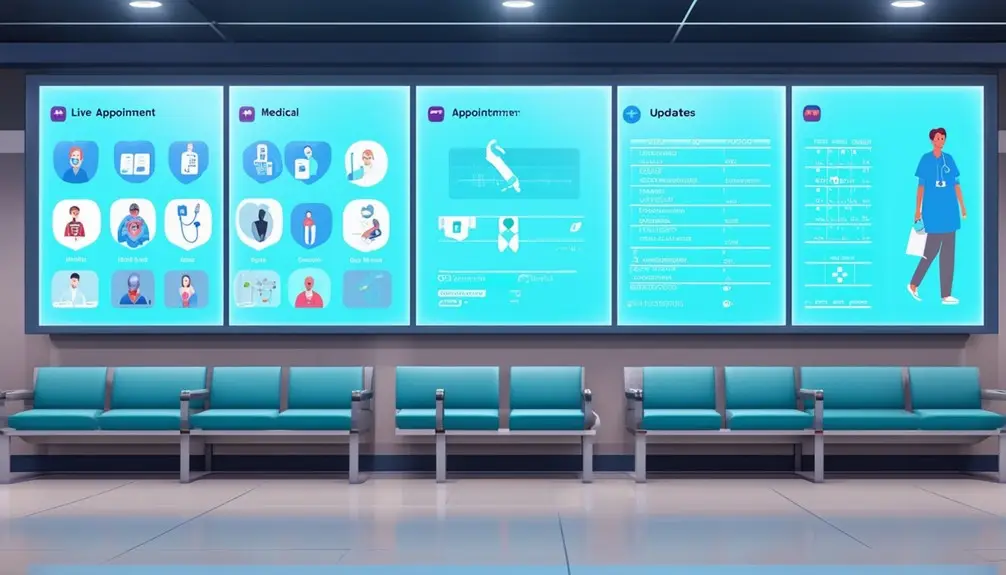Enhance patient experience and streamline operations with real-time digital signs for medical appointments. These signs integrate seamlessly with internal systems, providing live updates on wait times and appointment schedules. They reduce patient anxiety by delivering timely information and emergency alerts. By displaying relevant content and directions, they optimize patient flow and improve satisfaction. These systems also facilitate efficient visitor navigation and bolster emergency preparedness. Real-time data guarantees smoother workflows and better communication. Discover how these elements can transform your healthcare facility’s operational efficiency and patient care, leading to greater satisfaction and safety.
Table of Contents
ToggleKey Takeaways
- Real-time digital signs reduce patient anxiety by providing live updates on appointment schedules and wait times.
- Integration with healthcare systems ensures timely updates and effective communication in medical facilities.
- Digital signs display emergency alerts, enhancing safety and preparedness in healthcare settings.
- Interactive self-service kiosks streamline check-in processes and offer multilingual support.
- Providers like Zoney offer user-friendly interfaces and powerful analytics tools for efficient content management.
Importance of Digital Signage
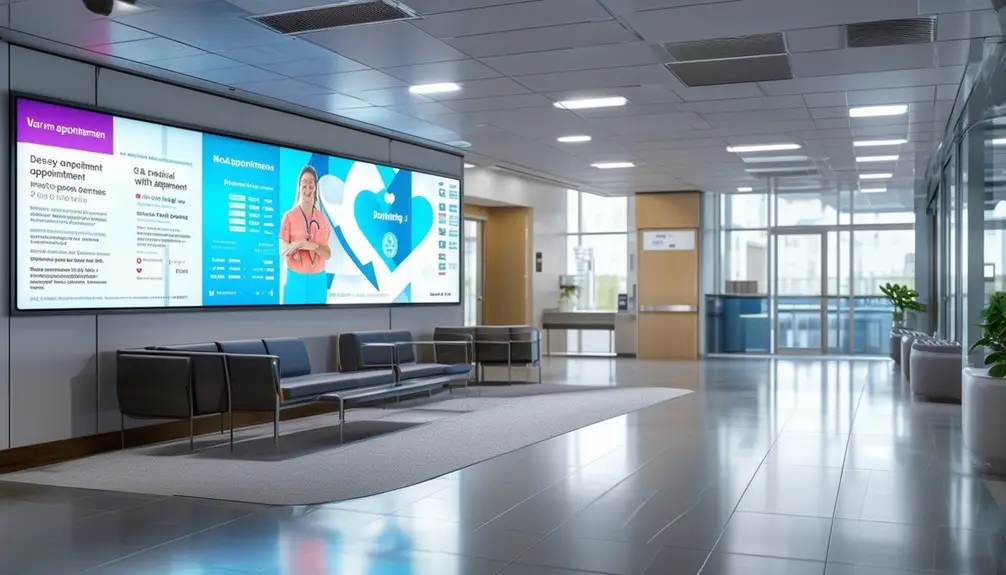
Digital signage in healthcare facilities is necessary for improving patient experience by reducing perceived wait times and providing vital information in real-time. When you walk into a healthcare facility, digital signage can be a game-changer for your visit. These signs display real-time information, ensuring you’re updated about your medical appointments and reducing any confusion about schedules.
Digital signage is designed to keep you informed. These systems can integrate seamlessly with internal healthcare systems to provide timely updates and emergency alerts. For example, platforms like Zoney offer robust features, allowing healthcare facilities to deliver essential information to patients and staff efficiently.
Digital signage enhances communication within the facility. Whether it’s displaying important announcements or guiding you through interactive wayfinding solutions, these signs streamline the information flow. This not only helps in maintaining order but also significantly enhances overall patient satisfaction.
In emergency situations, digital signage proves invaluable by disseminating vital information swiftly. You’ll notice how quickly and effectively these signs can communicate necessary actions, ensuring everyone’s safety. Through precise and timely communication, digital signage helps in creating a more organized and responsive healthcare environment.
Enhancing Patient Experience
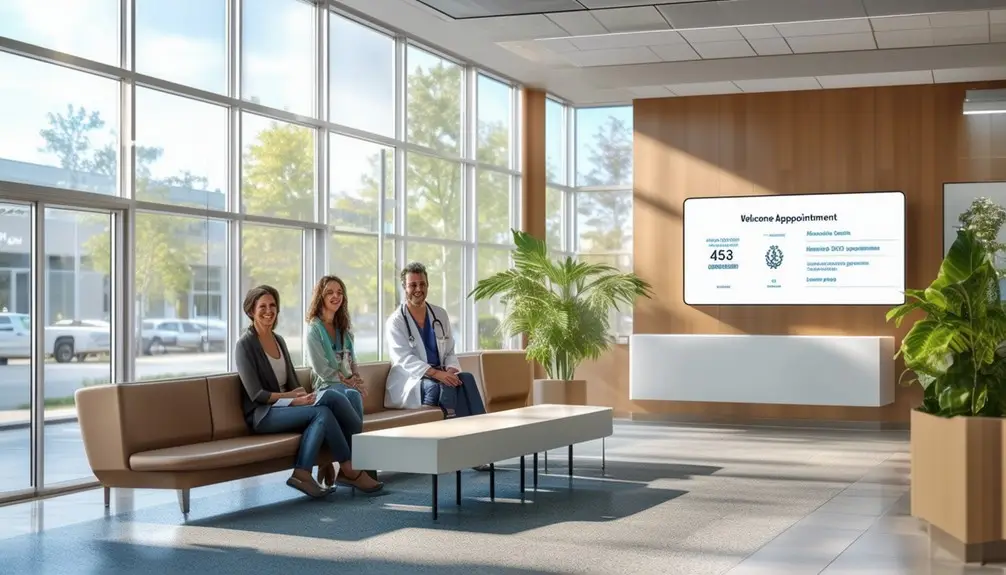
By providing live updates on appointment schedules and wait times, live digital signs greatly enhance the overall patient experience in healthcare facilities. When patients have access to up-to-date information via digital signage, their anxiety is notably reduced, leading to an improved experience. These live updates ensure patients are well-informed, minimizing uncertainty and confusion about their appointments.
Digital signage plays an essential role in enhancing patient satisfaction by delivering relevant content precisely when it’s needed. Knowing exactly when they’ll be seen by a healthcare professional allows patients to feel more in control and engaged in their care process. This level of transparency contributes to a higher perception of care quality.
With live updates displayed prominently, healthcare facilities can streamline patient flow, reducing bottlenecks and optimizing operations. This not only benefits the patients but also the healthcare providers, creating a more efficient environment. Immediate access to appointment information via digital signs directly translates to an enhanced patient experience, as it facilitates smoother, more predictable interactions within the facility.
Efficient Visitor Navigation
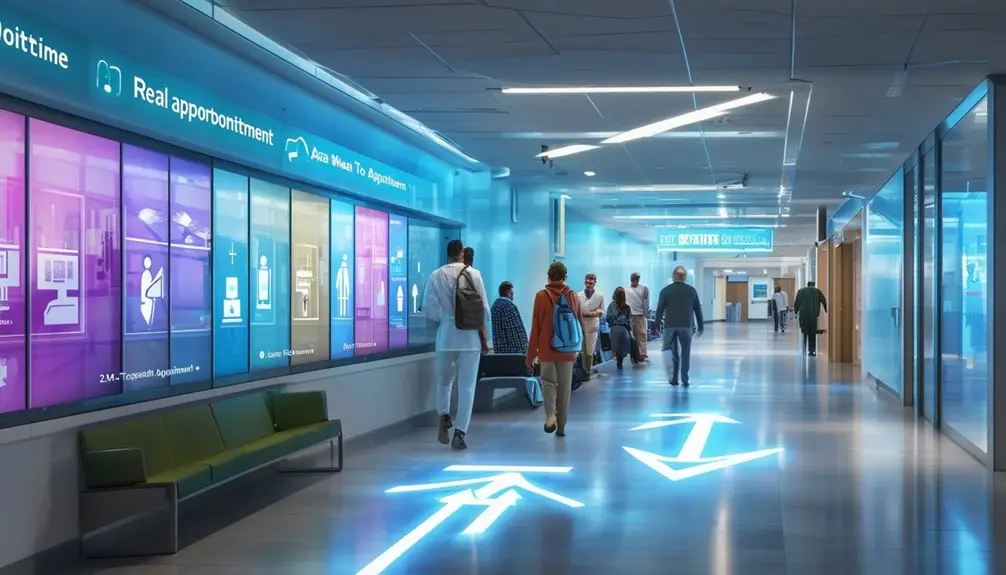
Utilizing real-time digital signs ensures that patients and visitors navigate medical facilities smoothly and confidently. Digital signage offers real-time updates on appointment schedules, wait times, and directions, greatly enhancing the visitor experience. By using interactive maps and wayfinding tools, you can reduce confusion and promote efficient navigation throughout the facility.
Integrating digital signs with existing systems enables live updates on patient schedules and locations. This level of detail guarantees that patients and visitors are always informed about where they need to be and when. Efficient navigation not only enhances patient satisfaction but also streamlines the overall operations within the medical facility.
Data indicates that reducing the time patients spend searching for their destinations can result in a more positive visitor experience. Real-time digital signs serve as a vital tool in delivering this effectiveness. When patients can navigate the facility without difficulty, they are more likely to feel relaxed and content with their visit. Staff can concentrate more on patient care rather than giving directions, further enhancing operational efficiency and patient satisfaction. Implementing these wayfinding tools is a strategic move to optimize both visitor experience and facility performance.
Real-Time Appointment Updates
Real-time appointment updates on digital signs keep patients informed and minimize anxiety by providing accurate, live information about their schedules and wait times. In healthcare facilities, these digital signs play an important role in enhancing patient experience and improving operational effectiveness.
By implementing real-time appointment updates, you ensure patients can quickly check their status and receive notifications of any schedule changes. This immediate access to information not only reduces anxiety but also creates a smoother, more organized workflow in medical settings. Real-time updates are particularly effective in managing patient flow and reducing bottlenecks, which is vital for maintaining an efficient healthcare environment.
Consider the following benefits of using real-time digital signs in healthcare facilities:
- Enhanced Patient Experience: Patients feel more at ease when they have access to up-to-date information about their appointments and wait times.
- Improved Staff Efficiency: Staff can focus more on patient care rather than managing appointment inquiries, thereby increasing overall operational effectiveness.
- Reduced Operational Costs: Real-time updates help decrease the need for manual communication, thereby cutting down on administrative overhead.
Emergency Alerts and Notifications
In pivotal situations, digital signs in medical facilities provide swift information dissemination, ensuring staff, patients, and visitors receive real-time updates. You can count on these signs to display vital emergency alerts, such as evacuations or lockdowns, instantly improving response times. By presenting important updates and safety procedures, digital signage greatly enhances safety and preparedness across healthcare settings.
Swift Information Dissemination
Swift information dissemination through digital signs plays an essential role in ensuring patients, visitors, and staff receive immediate emergency alerts and notifications, thereby enhancing overall safety and preparedness in healthcare facilities. Real-time digital signs are indispensable tools for sharing important information during emergencies, ensuring everyone in the facility is informed without delay.
By utilizing real-time digital signs, healthcare facilities can:
- Quickly disseminate emergency alerts: Digital signs provide instant notifications, including evacuation instructions and safety protocols, ensuring timely and coordinated responses.
- Enhance communication of critical information: Real-time updates on digital signs allow for immediate dissemination of significant information like contact details for emergency assistance.
- Improve overall crisis management: Effective use of digital signage reduces response times and improves the efficiency of emergency procedures.
When an emergency occurs, the speed at which information is shared can greatly impact outcomes. Digital signs eliminate the lag associated with manual communication methods, ensuring that both staff and patients receive up-to-date information promptly. This real-time dissemination of emergency alerts and notifications is important for maintaining a safe and well-prepared healthcare environment. By leveraging real-time digital signs, healthcare facilities can better manage emergencies, ultimately safeguarding the well-being of everyone within their walls.
Critical Updates Display
Displaying important updates such as emergency alerts and notifications on digital signs guarantees patients and staff stay informed and prepared in real-time. In healthcare facilities, the ability to provide immediate updates directly impacts the efficiency of communication and the overall patient experience. For instance, when an emergency alert is issued, these digital signs can instantly relay essential information, ensuring everyone is aware of the situation and knows the necessary actions to take.
Real-time updates also play a significant role in managing appointment schedules. Patients and staff benefit from timely notifications about schedule changes or cancellations, which helps in reducing confusion and ensuring smooth operations within the facility. Efficient communication through digital signs minimizes delays and enhances the overall workflow.
The swift display of emergency alerts on digital signs is particularly important for emergency preparedness and response. When critical notifications are communicated promptly, healthcare facilities can better manage resources and personnel, thereby improving patient outcomes and safety. Essentially, digital signs serve as an indispensable tool for delivering real-time updates, fostering an environment where patients and staff are consistently well-informed and prepared for any situation.
Reducing Wait Times
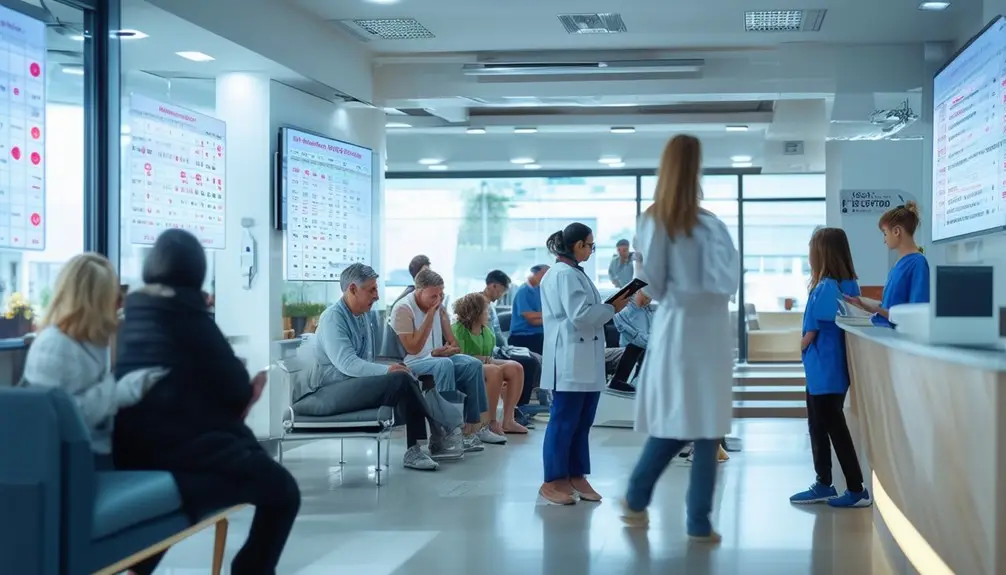
To decrease patient wait times, you can leverage real-time digital signs that provide efficient queue management and timely updates. These signs guarantee patients have access to their current appointment status, minimizing anxiety and improving satisfaction. Implementing interactive self-service kiosks further streamlines the check-in process, optimizing patient flow and operational efficiency.
Efficient Queue Management
How can real-time digital signs revolutionize queue management in healthcare by cutting patient wait times by up to 33%? Real-time digital signs are a game-changer in efficiently managing waiting areas. By integrating queue management systems with real-time data, they enable efficient communication between staff and patients throughout the appointment process. This clarity helps to streamline operations and reduce wait times, directly enhancing patient satisfaction.
Here’s how real-time digital signs make a difference:
- Prioritizing Appointments: Digital signs use real-time data to prioritize patient appointments accurately. This guarantees that patients who need immediate attention are seen first, optimizing the flow and reducing unnecessary delays.
- Optimizing Workflow: Live appointment schedules displayed on digital signs allow staff to manage their time more effectively. By knowing exactly when patients are arriving and who needs to be seen next, healthcare providers can minimize downtime and keep the appointment process moving smoothly.
- Enhancing Communication: With up-to-the-minute updates, digital signs facilitate efficient communication between staff and patients. This transparency helps reduce anxiety in waiting areas as patients are kept informed about their wait times and the status of their appointments.
Real-Time Updates
Real-time digital signs drastically cut patient wait times by continuously updating appointment schedules and providing instant notifications. By displaying real-time updates, these signs ensure patients have access to the most current information regarding their appointments. This dynamic adjustment of schedules helps reduce patient wait times significantly, minimizing the uncertainty and stress often associated with medical visits.
You’ll find that real-time updates can inform you of any delays or changes in your appointment schedule right away. This constant flow of information helps streamline the check-in process, making it more efficient. Patients no longer need to repeatedly check with the front desk for updates, freeing up staff to focus on other critical tasks.
These digital signs enhance patient satisfaction by keeping you informed and engaged. Knowing exactly when you’ll be seen helps you plan your time better and reduces overall frustration. The increased transparency and reduced waiting times contribute to a more positive experience, directly improving the operational efficiency of the medical facility.
In essence, real-time digital signs not only reduce patient wait times but also create a smoother, more satisfying experience for everyone involved.
Interactive Self-Service Kiosks
Interactive self-service kiosks can decrease patient wait times by up to 30%, streamlining the check-in process and enhancing overall efficiency. By leveraging these digital kiosks, you enable patients to handle tasks such as checking in, verifying insurance, and updating personal information with ease. This not only speeds up the check-in process but also frees up your staff to focus on providing quality care.
Interactive kiosks display real-time appointment schedules, minimizing confusion and improving the patient experience. Patients can see exactly when and where they need to be, reducing the likelihood of missed or delayed appointments. Additionally, these kiosks offer multilingual support, making the system accessible to a broader, more diverse patient population.
Here are three key benefits of implementing interactive kiosks:
- Decreased Patient Wait Times: By expediting the check-in process, digital kiosks can reduce your patient wait times by up to 30%.
- Improved Efficiency: Real-time appointment schedules reduce confusion, allowing your staff to manage patient flow better and attend to urgent needs promptly.
- Enhanced Accessibility: Multilingual support ensures that patients from various backgrounds can easily navigate the system, improving overall patient satisfaction.
Incorporating interactive kiosks into your practice can greatly enhance operational efficiency and patient care.
Integration With Internal Systems
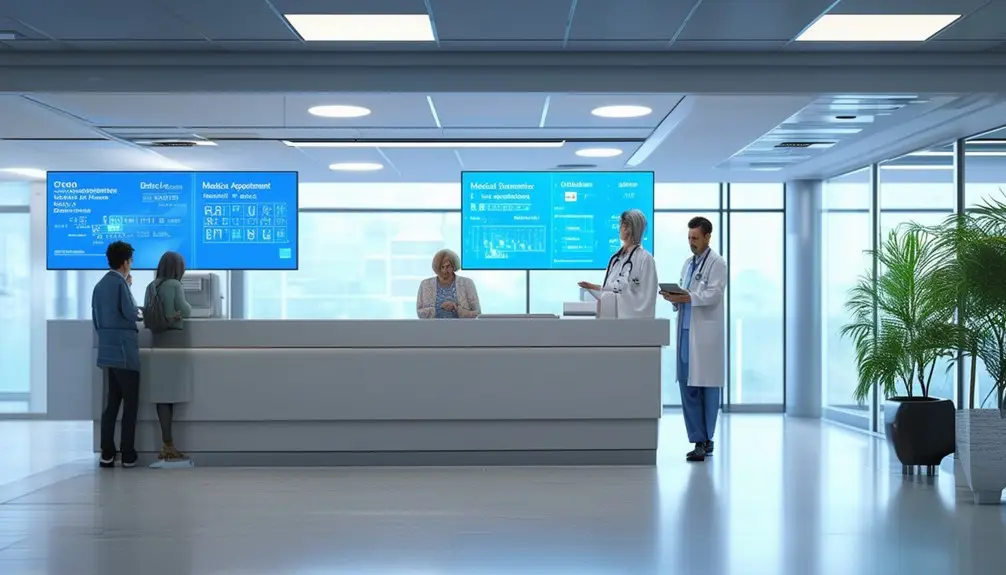
Integrating digital signage with internal systems allows healthcare facilities to automatically display real-time patient schedules and updates, enhancing operational efficiency and patient satisfaction. With this integration, you guarantee appointment information is always accurate and up-to-date, which is crucial for both staff and patients.
By utilizing real-time patient schedules, digital signs can instantly reflect appointment updates, streamlining operations and guaranteeing efficient communication. This automatic update capability reduces the administrative burden on your staff and minimizes the likelihood of errors, ultimately leading to a smoother workflow.
Patients benefit from seeing current scheduling information, which boosts their confidence in the facility’s organization and reliability. Accurate and timely information displayed on digital signs can significantly improve patient satisfaction by reducing wait times and confusion.
| Benefit | Description |
|---|---|
| Real-time Patient Schedules | Displays the most current appointment information automatically. |
| Efficient Communication | Guarantees that both staff and patients are aware of any changes instantly. |
| Streamlines Operations | Reduces manual updates, freeing up staff for other vital tasks. |
Integrating digital signage with internal systems is a game-changer for healthcare facilities, offering a seamless way to manage and communicate appointment-related information. This approach not only streamlines operations but also enhances the overall patient experience.
Content Management Tips
A cloud-based content management system ensures you can easily update and schedule appointment information in real-time, enhancing both staff efficiency and patient satisfaction. This system’s ability to seamlessly integrate with your clinic’s internal scheduling tools guarantees that digital signage content is always accurate and up-to-date. To make the most of this technology, consider the following tips:
- Display Real-Time Wait Times: By showing live updates on wait times, you keep patients informed and manage expectations, reducing anxiety and improving overall experience.
- Utilize Interactive Features: Incorporate touchscreens that allow patients to check-in, view appointment details, or even reschedule. This not only streamlines appointment management but also empowers patients with more control over their visits.
- Customize Content for Relevance: Tailor the digital signage content to include appointment reminders, health tips, and clinic updates. This personalized approach can make the wait more engaging and informative, further enhancing patient experience.
Efficient content management is key to leveraging the full potential of your digital signage. By focusing on real-time data, interactive features, and relevant content, you create a dynamic and patient-centric environment that ultimately boosts satisfaction and operational efficiency.
Top Digital Signage Providers
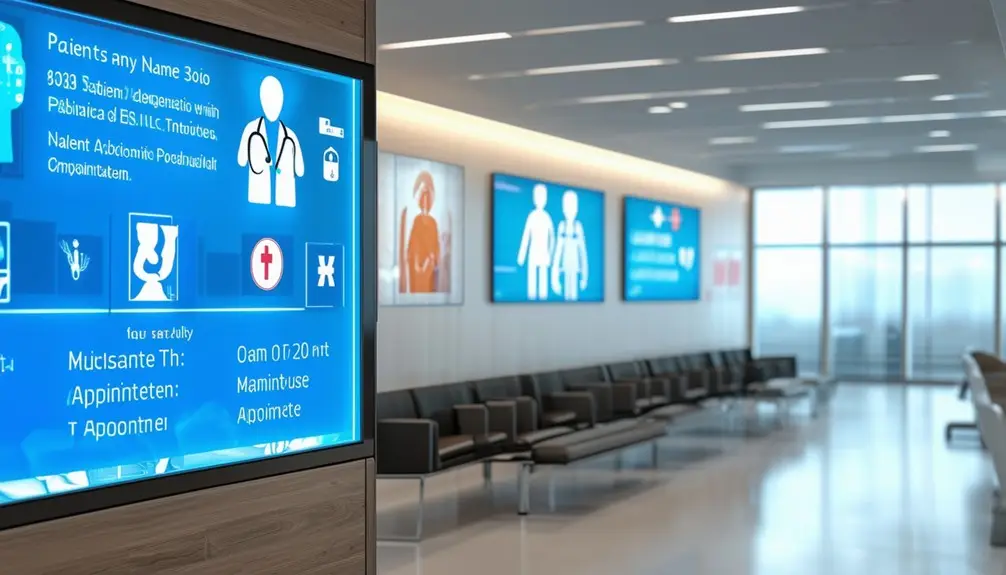
Several top-tier digital signage providers offer robust solutions for displaying real-time medical appointment information, ensuring patients stay informed and on schedule. By integrating their healthcare digital systems with your scheduling software, these providers guarantee accurate and timely updates that enhance patient experience and operational efficiency.
Zoney stands out with its cloud-based digital signage software, enabling easy content management and scheduling. You can effortlessly update appointment information, and comprehensive patients and visitors always have access to the latest details. The software also supports customizable templates, allowing you to create engaging content tailored to your specific needs.
These digital signage solutions are designed to be user-friendly, making it simple for your staff to manage and update content. This ensures that patients and visitors receive clear, concise, and up-to-date information at all times. By choosing a top digital signage provider, you’re investing in a technology that enhances patient satisfaction and streamlines your healthcare operations.
Conclusion
By embracing real-time digital signs, you’ll kill two birds with one stone: improving patient satisfaction and streamlining operations. These signs offer real-time updates, efficient navigation, and emergency alerts, making your facility more responsive and reducing wait times. Integrate with internal systems for seamless operation and utilize top providers for the best results. With the right content management strategies, you’ll see a significant boost in patient experience and operational efficiency.
Frequently Asked Questions
What Is Real Time in Digital Signage?
Real-time in digital signage means displaying live, up-to-the-minute information instantaneously. You’ll see current data like schedules and updates, which enhances communication, reduces confusion, and improves efficiency. It’s a game-changer for patient-centric care.
What Is Healthcare Digital Signage?
Did you know 70% of patients feel less anxious with real-time updates? Healthcare digital signage is a tool in medical facilities that displays appointment schedules, wait times, and health tips, enhancing communication and improving your overall patient experience.
What Is Interactive Digital Signage?
You can engage with interactive digital signage through touchscreens or gestures, accessing real-time information and updates. This technology enhances communication, reduces wait times, and improves patient satisfaction by providing personalized and efficient experiences in healthcare settings.
What Is Automated Digital Signage?
Imagine a modern-day telegram. Automated digital signage uses real-time data to update and display appointment schedules and wait times. It integrates with scheduling software and EMRs, keeping patients and staff informed, improving efficiency, and enhancing satisfaction.
Related posts:
 Streamline Operations: Enhance Efficiency with Digital Patient Data
Streamline Operations: Enhance Efficiency with Digital Patient Data
 From ER to Specialists: Comprehensive Digital Scheduling Solutions for Hospitals
From ER to Specialists: Comprehensive Digital Scheduling Solutions for Hospitals
 Real-Time Healing: How Live Scheduling Boards Are Reshaping Patient Care
Real-Time Healing: How Live Scheduling Boards Are Reshaping Patient Care
 Elevate Patient Care Coordination: Electronic Status Boards for Busy Hospitals
Elevate Patient Care Coordination: Electronic Status Boards for Busy Hospitals
